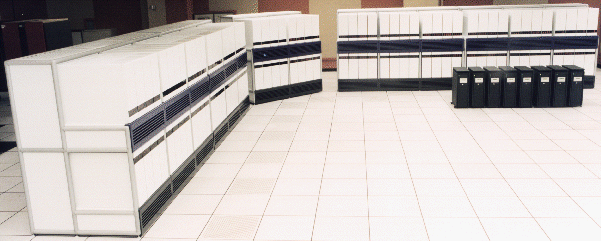I’ll put up another article or 2 if I have time about the Cambridge Raspberry Jam event held on the 14th of July 2012… However…
One of the things that struck me was a comment from Eben that he had a box of 200 Raspberry Pis (for sale) and he noted how easy it was to carry it and made a comment about the potential computing power.
It struck a note with me, as some time back (1988-1995!) I worked for a UK based supercomputer company called Meiko Scientific and one of the projects I worked on was a 256-node supercomputer installed at the Lawrence Livermore National Laboratories in California… (It was one of Meikos CS2 units – Computing Surface mk 2)
This is a picture of that Supercomputer, which at the time was the fastest supercomputer on the planet:

The Meiko CS2 at LLNL
Now, without knowing what you’re looking at, it’s hard to get an idea of how big that is… The cabinets are 2 metres high. The whole is arranged into bays of 3-module widths (4 bays) and 2-module width (the smaller one on a diagonal in the middle). It’s that big “L” shape due to the nature of the cabling between the modules – it goes diagonally under the floor. (The middle sections of each bay is a set of network switches) The stand-alone black boxes are RAID arrays with (from memory) 20 x 4GB drives each.. (they were later moved inside some of the modules, but at that time the mechanicals weren’t in-place)
This was 1993/1994 or thereabouts.
Inside that, amongst other things are 256 compute nodes. 4 to one of the smaller modules that you see. Each smaller module is rated at up to 1 KW in power consumption terms. Those compute modules were about 14 inches square and contained a dual-processor sparc at 66MHz and 128MB of RAM. It ran a variant of Solaris. It booted over the network, but each node also had a local 1GB SCSI drive. (There was an additional control bus and “stuff” associated with that to give us node control like power, monitoring and console which added a little to the board, as well as the high speed data network)
So think about that for a moment… A single Raspberry Pi is probably faster than each of those sparc boards. (and at 700MHz vs 66MHz, it’s a lot faster!) The Pi also has double the RAM. The CS2 boards did have a blisteringly fast (for the time) communications network – 750Mbits/sec with a very low latency between nodes. A lot faster than the Pi’s max. of 100Mbits/sec. into a switched Ethernet network, however I could build an equivalent “supercomputer” based on 256 Raspberry Pis, put it under my desk and power it from a 13A socket. And that’s just using the ARMs – not even thinking of the GPUs…
Still – it’s somewhat interesting to think that Eben can carry a box of 200 Pi’s representing something that 20 years ago was simply incomprehensible to think about at the time.
(Minor update to change network speeds to bits/sec!)
